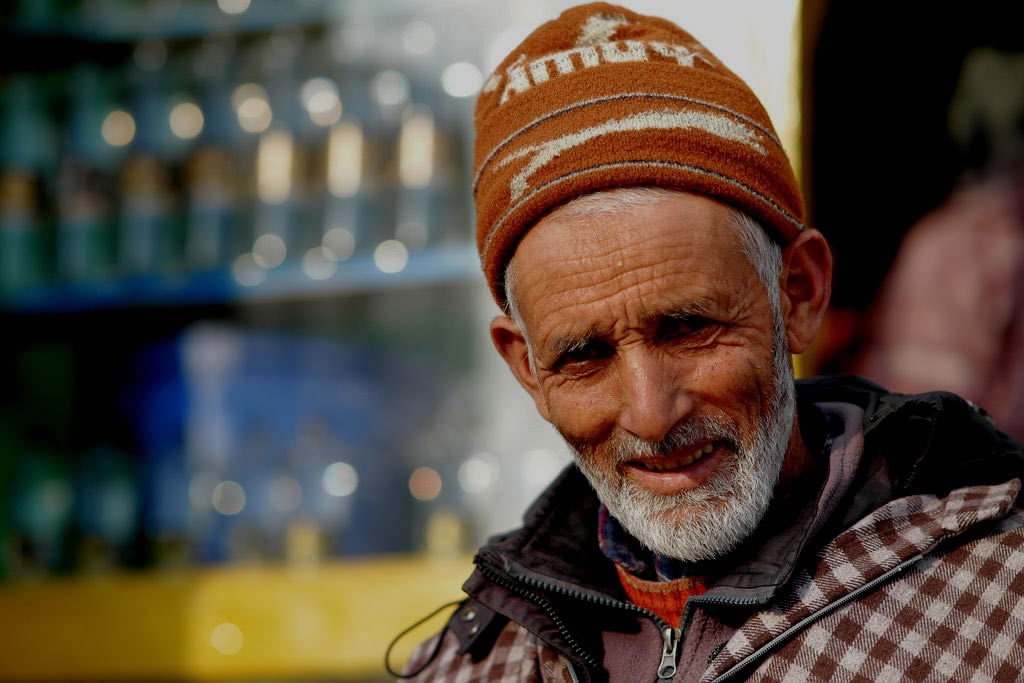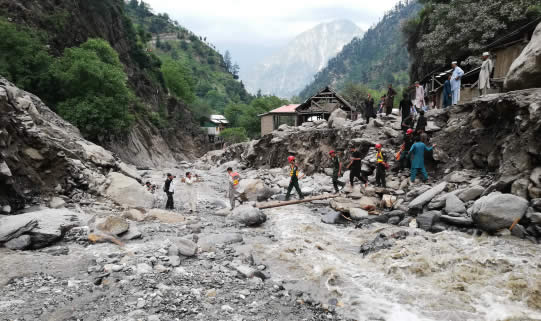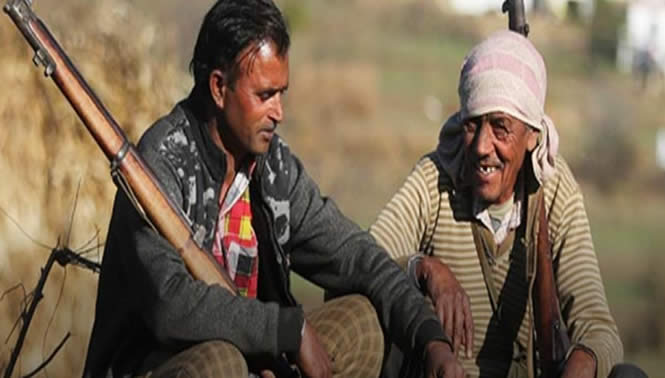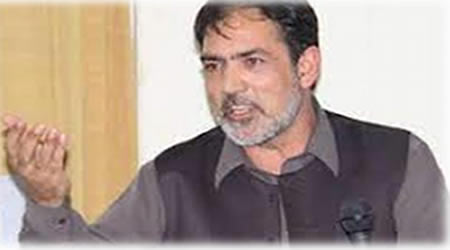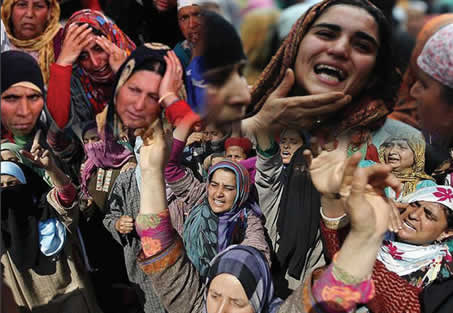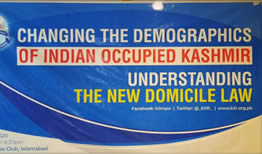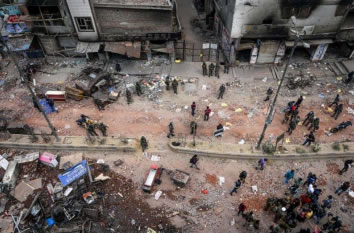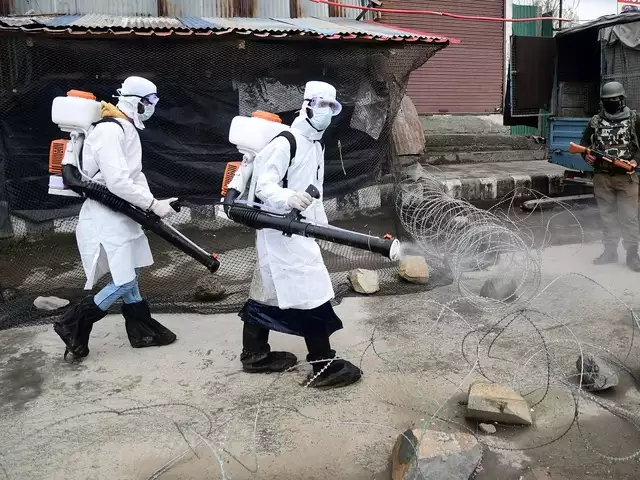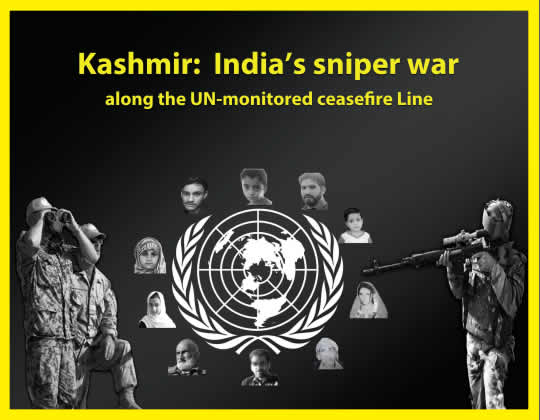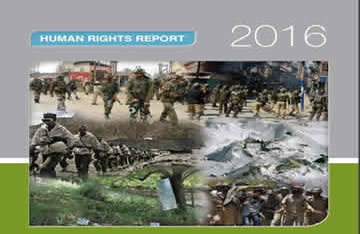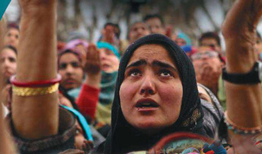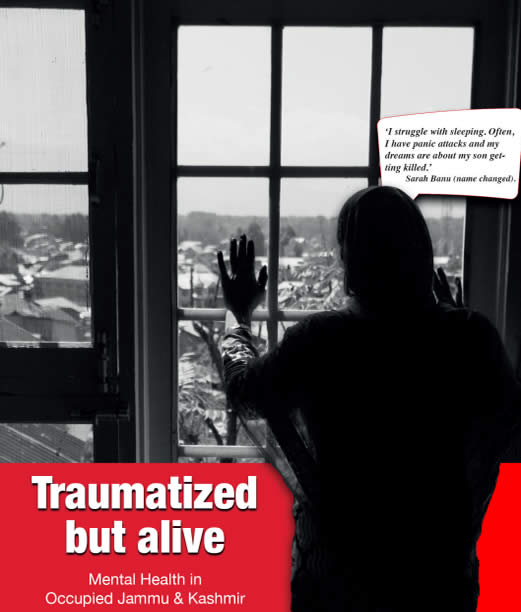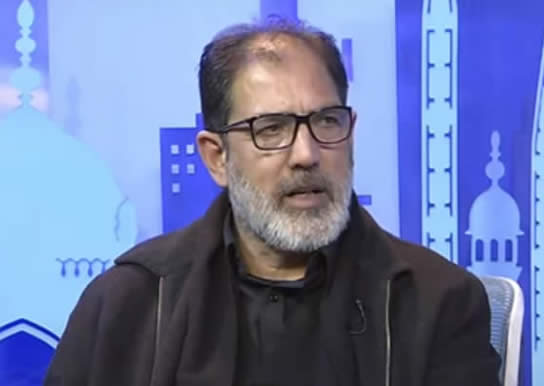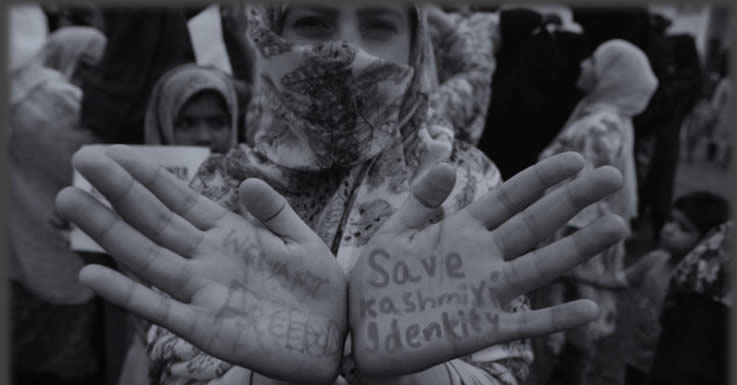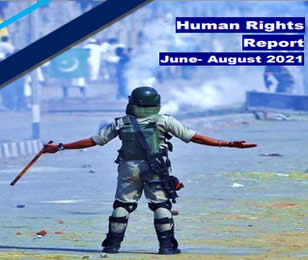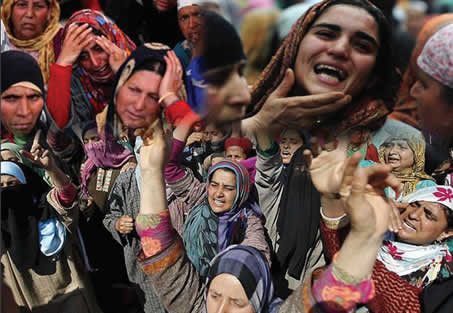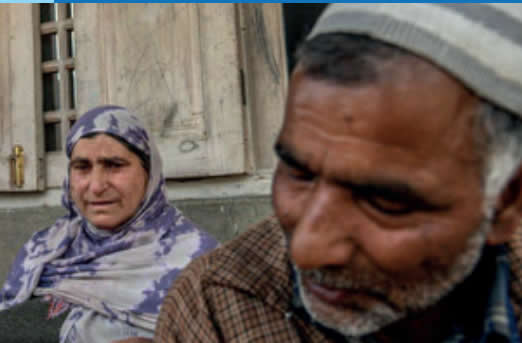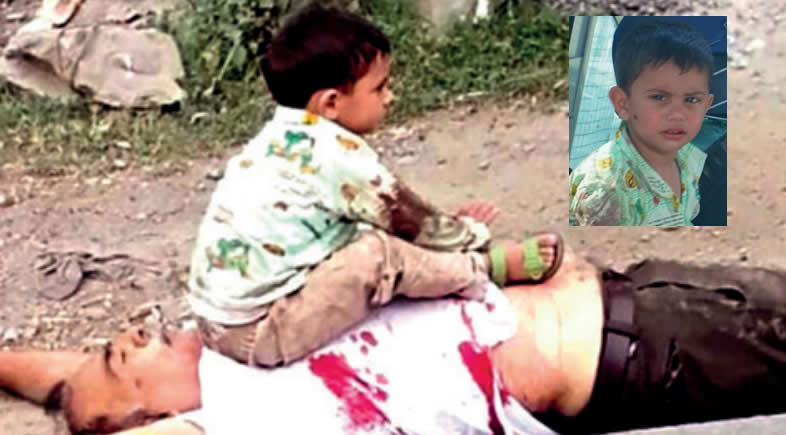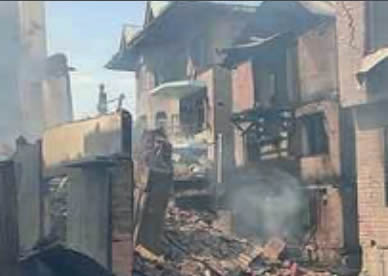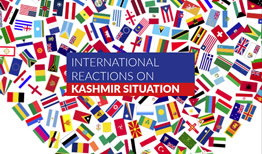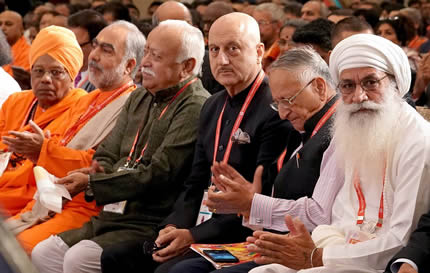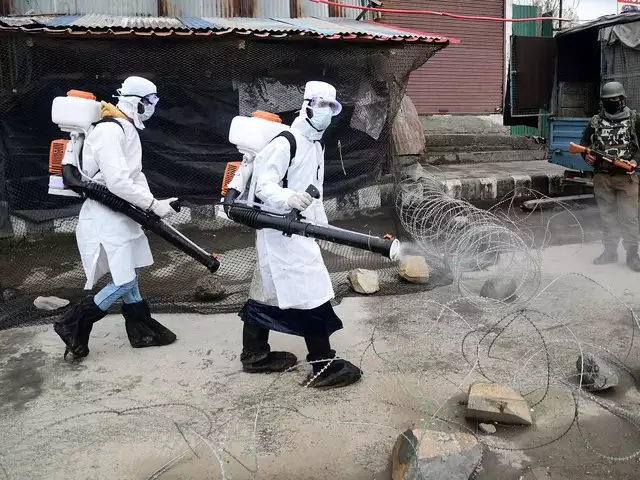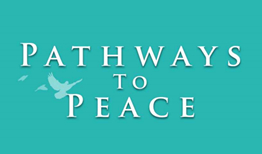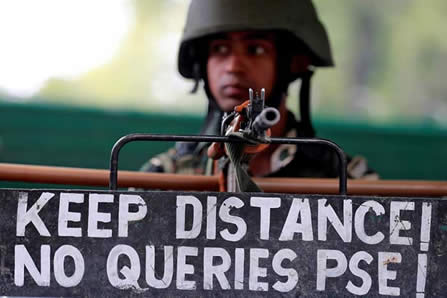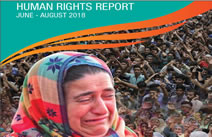Human Rights Report
Human Rights Report
INTRODUCTION
India’s approach to governance in the Indian-occupied Jammu and Kashmir (IoJK) exemplifies colonial tactics characterized by militarization, suppression of dissent, and systemic human rights violations. Since the region’s controversial accession to India in 1947, the Indian state has employed a strategy of heavy militarization to assert control over the disputed territory. This approach has been marked by numerous incidents of extrajudicial killings, arbitrary detentions, and targeted violence against civilians, which collectively underscore the severity and frequency of state-sponsored violence. Such actions reveal a pattern of coercive governance aimed at consolidating Indian sovereignty over the region.
The reintroduction of Siege and Search Operations (SASO) in IoJK has further entrenched the militarization of Jammu and Kashmir. These operations have led to widespread civilian distress due to arbitrary detentions, property destruction, and excessive use of force. This strategy not only exacerbates human suffering but also highlights the state’s reliance on coercive measures to maintain control, undermining the region’s stability and security. Moreover, the Indian government’s use of laws such as the Unlawful Activities Prevention Act (UAPA) and the Public Safety Act (PSA) to conduct arbitrary detentions reflects a broader tactic of suppressing dissent and controlling the populace.
These legal frameworks, often criticized for their draconian nature, allow for the detention of individuals without trial, raising serious human rights concerns and illustrating the repressive nature of India’s security policies in the region. The unlawful destruction of homes in Kashmir is another stark example of the colonial tactics employed by India. By systematically demolishing civilian properties and displacing innocent families, the Indian state not only violates basic human rights but also seeks to terrorize the population into submission. This tactic of collective punishment is emblematic of colonial strategies aimed at breaking the will of the people through fear and intimidation.
The Modi-led Indian government’s use of the National Investigation Agency (NIA) and the State Investigation Agency (SIA) to target and intimidate Kashmiri leaders, human rights activists, journalists, and ordinary citizens underscores a deliberate effort to stifle dissent and silence opposition. These agencies, operating under the pretext of national security, often engage in raids and confiscations that serve to instill fear and suppress any resistance to the Bharatiya Janata Party’s (BJP) policies. The media freedom in IIOJK is severely curtailed, with journalists facing harassment, intimidation, and violence. This crackdown on press freedom not only violates international norms but also aims to control the narrative and prevent the dissemination of information that could challenge the state’s authority. The systematic targeting of journalists further demonstrates the colonial tactics employed to maintain a hegemonic grip over the region.
Furthermore, the termination of public employees under Article 311 of the Indian Constitution has exacerbated unemployment in IIOJK. These dismissals, often justified on grounds of alleged anti-national activities, disrupt individual livelihoods and contribute to the socio-political instability in the region. By systematically removing those perceived as dissenters from public service, the Indian government seeks to consolidate its control and weaken any potential opposition. The Indian state’s approach to Jammu and Kashmir, characterized by militarization, human rights abuses, suppression of dissent, and control over media and public employment, aligns with classic colonial tactics aimed at maintaining dominance over a subjugated population. These strategies not only violate international norms and exacerbate regional tensions but also highlight the ongoing challenges to peace and stability in the region.
EXTRAJUDICIAL KILLINGS IN INDIAN OCCUPIED JAMMU AND KASHMIR
The increasing militarization of Jammu and Kashmir by Indian forces has led to numerous incidents of extrajudicial killings and targeted violence against civilians. This pattern of state violence can be analyzed through various incidents, revealing the severity and frequency of these acts.
a) Chronological Overview of Incidents
January 5: Indian troops martyred a Kashmiri youth, Bilal Ahmed Bhat, in Shopian district during a siege and search operation in the Chotigam area. This
operation highlights the targeted killings by Indian forces.
February 7: Amritpal Singh, a resident of Amritsar, Punjab, was shot dead by Indian Army in Srinagar, marking the second targeted killing in Kashmir Valley for the year. Also, migrant worker Rohit Mashi, 25, succumbed to injuries after being targeted by Indian arm. These incidents reflect the vulnerability of non-local residents and the pervasive insecurity in the region. 1
March 1: The Chinar Corps of the Indian Army reported that Indian forces killed a civilian and his son in the Kellar area of Shopian District.2
March 9: Habibullah Shergojri, an elderly man, was crushed to death by an Indian forces’ vehicle in Bandipora’s Gulshan Chowk area. This incident underscores the collateral damage and often lethal consequences of militarization on ordinary civilians.
March 18: Muhammad Mushtaq was killed by Indian forces in Rajouri.3
April 5: The Indian army violated ceasefire by resorting to unprovoked firing at Sabura Nala Rustam in the Uri area of Baramullah. Such operations frequently result in civilian casualties and further destabilize the region.4
April 11: Danish Sheikh was killed during a cordon and search operation in Fressipora village of Pulwama district. This incident reflects the use of lethal force during routine search operations.5
April 17: Raju Shah, a laborer from Bihar, was shot dead by Indian army in Anantnag. This killing from point-blank range exemplifies the ongoing threats faced by civilians in the region.
April 22: Mohd Razaq and his brother were killed by Indian army in the Sharda Shrief area of Thanamandi in Rajouri district.
April 26: Abu Maaz and his friend Faraz were killed in Sopore’s Mohalla Nowpora during a siege-and- search operation. The operation also resulted in injuries to several civilian, demonstrating the high- risk environment for Kashmiris.6
April 28: Mohd Sharief, a Village Defence Guard (VDG) member, was killed by Indian army in Udhampur, highlighting the persistent threat to locals in Jammu and Kashmir.7
b) Strategic and Political Considerations
The pattern of killings and violence in Jammu and Kashmir can be examined through several key International Relations (IR) concepts:
i. State-Sponsored Violence: The killings by Indian forces and their collateral damage can be categorized as state-sponsored violence. These actions are often justified under the guise of search operations but result in significant civilian casualties and human rights violations.
ii. Human Security: The extrajudicial killings and targeted violence significantly undermine human security in the region. This concept emphasizes the protection of individuals rather than the state and the ongoing violence in Kashmir highlights the failure to safeguard civilian lives.
iii. Impunity: The lack of accountability for these killings reflects a culture of impunity within the security apparatus. Despite numerous civilian deaths, there is often little to no legal recourse for the victims’ families, undermining the rule of law and justice.
iv. Internal Colonialism: The heavy-handed tactics targeting killings and militarization can be seen as elements of internal colonialism, where the state exerts oppressive control over a resistant population to maintain its sovereignty and territorial integrity
The documented incidents of extrajudicial killings and violence against civilians by Indian forces in Jammu and Kashmir reveal a persistent pattern of state-sponsored violence and human rights abuses. The use of excessive force during routine search operations, the targeting of non-combatants and the pervasive impunity highlight the severe human security crisis in the region. These actions not only violate international human rights norms but also exacerbate the longstanding conflict and distrust between the local population and the Indian state.
INCREASING MILITARIZATION IN INDIAN OCCUPIED JAMMU AND KASHMIR
The Indian state has progressively intensified its militarization of Jammu and Kashmir since October 27, 1947. This militarization serves as a cornerstone of India’s strategy to maintain control over the disputed region, a tactic that can be analyzed through various incidents and developments over recent months. Below, the following chronological analysis of key events and actions underscore this trend.
a. Chronological Overview:
January 1: The Jammu and Kashmir Police Name of Victim Date Place of Incident Killed By Bilal Ahmed Bhat January 05 Chotigam, Shopian Indian troops Amritpal Singh February 07 Shaheed Gunj, Srinagar Indian troops Rohit Mashi February 07 Srinagar Indian troops Civilian and his son March 01 Kellar, Shopian Indian troops Habibullah Shergojri March 09 Gulshan Chowk, Bandipora Indian troops Mohammad Mustaq March 18 Chingus, Rajouri Indian troops Danish Sheikh April 11 Fressipora, Pulwama Indian troops Raju Shah April 17 Jablipora, Bijbehara, Anantnag Indian troops Mohd Razaq April 22 Sharda Shrief, Thanamandi, Rajouri Indian troops Abu Maaz and Faraz April 26 Mohalla Nowpora, Sopore, Baramulla Indian troops Mohd Sharief April 28 Remote village, Udhampur Indian troops January-April 2024 Kashmir Institute of International Relations7 introduced a policy offering significant cash rewards for information on cross-border tunnels, drone activity and terrorist networks.
Rewards range from Indian-Rs. 100,000 for information on recruitment activities to Indian-Rs.1.25 million for details leading to the capture or elimination of terrorists. This policy aims to incentivize local cooperation in counter-insurgency operations, thereby deepening the securitization of the region.8
January 31: The Indian government deployed specialist armored vehicles to the region. The Light Specialist Armored Vehicles (LSVs), developed at the Ordnance Depot in Avadi, Chennai, were dispatched to Jammu and the Kashmir Valley. 9
February 3: Indian troops opened a fire at the Line of Control (LoC) in Sabra Gali, Poonch district.10
February 15: The Indian Election Commission sanctioned the deployment of 635 Central Armed Police Force (CAPF) companies in Jammu and Kashmir for Lok Sabha election duties. This deployment was the second highest after West Bengal, illustrating the control during the electoral process in the region.11
March 3: The High Court of Jammu and Kashmir and Ladakh’s directive to the Building Operation Controlling Authority (BOCA) Gulmarg to expedite the Indian Army’s construction applications reveals a colonial tactic aimed at consolidating control over the region. By prioritizing military infrastructure development, including in strategically significant areas like Gulmarg with its High Altitude Warfare School (HAWS), the court integrates judicial support with military expansion. This move highlights the colonial strategy of using infrastructure and legal systems to entrench and expand India’s dominance in the disputed territory.12
March 14: Jammu Police launched an aggressive initiative to apprehend freedom fighters. The operation includes public announcements, poster campaigns and community involvement tactics such as playing drums around the houses of the accused. This strategy reflects the increasing militarized approach aimed at maintaining control and authority.13
April 7: A contingent of women personnel from the Special Operations Group of the Jammu and Kashmir Police was deployed in Jammu ahead of the Lok Sabha elections scheduled for April 26. This deployment further illustrates India’s militarization of the region.14
b. Strategic and Political Considerations:
India’s increasing militarization of Kashmir can be examined through the lenses of security dilemma, internal colonialism and state sovereignty.
i. Colonialism: The deployment of armored vehicles, specialist police units and incentives for civilian cooperation in counter-terrorism can be seen as elements of internal colonialism, where a state employs coercive measures to maintain control over a resistant population. The substantial military presence, including one million troops, further exemplifies this.
ii. Assertive Control: India’s initiatives in Kashmir, such as the accelerated construction of military infrastructure and intensified security protocols during elections, signify its endeavor to assert control over the region. The judiciary’s endorsement of military expansions further emphasizes India’s pursuit of consolidating authority over Kashmiri territories and quelling internal dissent. The militarization of Kashmir by India involves a multi-faceted approach that includes financial incentives for intelligence gathering, the deployment of specialized military equipment and forces and legal endorsements for expanding military infrastructure. These actions underscore India’s intent to maintain a robust control over the region amidst ongoing dissent and geopolitical tensions
SIEGE AND SEARCH OPERATIONS
Siege and Search Operations (SASO), a strategy reintroduced in Jammu and Kashmir in 2017, have been marked by human rights violations, including arbitrary detentions, destruction of property and excessive use of force. These operations, characterized by a military siege and thorough searches, aim to root out insurgents but often result in widespread civilian distress.
a) Chronological Overview of Incidents
January 3: Indian troops launched the first siege and search operation of the year in Kulgam district, leading to widespread fear among residents due to the firing by troops.
January 7-8: A massive operation targeted Uchad village, Mendhar and nearby localities in Poonch, continuing for two days and extending into Rajouri. The operations involved cordoning off large areas and conducting thorough searches.
January 9: In anticipation of Republic Day, night curfew was imposed in Samba district. Simultaneously, intensified sieges and search operations were conducted across multiple districts including Srinagar, Kupwara, Baramulla, Bandipora, Ganderbal, Budgam, Islamabad, Pulwama, Shopian, Kulgam, Ramban, Kishtwar, Rajouri and Poonch.
January 12-15: Continued search operations in Poonch, particularly in Khanetar and Sawjian areas. These operations utilized sniffer dogs and aerial surveillance to intimidate locals. January 22: Joint forces of police, army and Central Reserve Police Force initiated extensive searches in Hariwala and Karamkatha areas in the Reasi District.
January 25: Siege and search operations were conducted in Doda, Kishtwar, Ramban, Rajouri and Poonch districts, specifically targeting households with pro-freedom sentiments. These actions were perceived as collective punishment.
January 30: Operations were launched along the Jammu-Pathankot Highway after the discovery of suspicious materials. This caused significant traffic diversions as occupation forces conducted searches along the highway.
February 4: Search operations in the forest areas of Rajouri and Poonch led to the detention of three individuals. The joint operations involved police, army and CRPF forces.15
February 8: Indian forces launched a siege and search operation in Reasi district.16
February 23: Extensive house-to-house searches were carried out in Pulwama following intelligence reports of freedom fighters. These operations involved large deployments and strict surveillance.17
March 1: A siege and search operation in Udhampur district involved joint forces conducting door-to-door searches, asserting control over the area.
March 5: Heightened military presence was implemented in Srinagar ahead of Prime Minister Narendra Modi’s visit. This included increased checkpoints, surveillance and the deployment of additional paramilitary forces.18
March 10: In Sopore, freedom fighters house was destroyed. The operation was conducted jointly by Jammu and Kashmir Police and Indian forces.
March 17: Indian forces launched a siege and search operation in Poonch.19 March 20: A massive search operation was launched in Samba district. The operation involved extensive searches in Khirdi, Sarna and surrounding villages. 20
March 23: A joint siege and search operation was conducted in Anantnag led to the arrest of two civilians. 21
March 29: Search operations were conducted in Rajouri. The forces fired rounds during the search operation.22
April 6: A siege and search operation in Rajouri district was initiated. Troops opened fire and conducted extensive searches.23
April 18: Extensive operations were conducted in forest areas of Rajouri and. These operations were part of heightened so called security measuresduring the election period.24
April 18: After the fatal shooting of Indian forces in Anantnag, Indian forces launched a large-scale search operation. Entry and exit points in the area were sealed.25
April 23: Operations were launched in Kunda village, Shahdara Sharief area of Rajouri’s Thanna Mandi tehsil. These operations included house-to- house searches.26
April 23: Indian forces conducted siege and search operation in Bandipora, Renji forests of the Aragam area.
April 27: A siege and search operation in Miran Sahib was conducted, prompting extensive searches in the area.27
April 30: Search operations in Udhampur continued for the third consecutive day, focusing on tracing two groups of terrorists. Drone surveillance was employed to aid the search efforts.2
SIEGE AND SEARCH OPERATIONS IN IOJK
This table summarizes the number of siege and search operations conducted by Indian forces in various regions of Jammu and Kashmir by month.
b) Implications
The continuous siege and search operations in Indian- occupied Kashmir underscore a systematic approach to control and suppress the local population, resulting in severe human rights violations. The extensive use of advanced weaponry, frequent imposition of curfews, and severe restrictions on movement highlight the oppressive nature of India’s military presence in the region. These actions not only disrupt the daily lives of the residents but also instill a pervasive sense of fear and uncertainty.
c) Human Rights Concerns:
i. Arbitrary Detentions and Use of Force: Numerous instances of detentions without due process and the disproportionate use of force, exemplified by events such as the January 3 operation in Kulgam and subsequent actions.
ii. Destruction of Property: Operations like those in Poonch (January 7-15) and Udhampur (March 1) frequently result in collateral damage to civilian properties.
iii. Psychological Impact: The prevailing atmosphere of fear and uncertainty, intensified by night curfews and ongoing sieges, profoundly affects the mental well-being of the local populace.
iv. Violation of Privacy: The broad powers granted to indian forces, allowing them to search any place and seize vehicles, raise concerns about privacy infringements and civil liberties violations.
v. Impact on Livelihoods: The disruption caused by SSOs, including restrictions on movement and economic activities, adversely affects the livelihoods of civilians, particularly those in conflict-affected areas.
d) Strategic and Political Considerations:
i. Security versus Rights Dilemma: These operations often erode trust between the state and local communities, exacerbating the mistrust problem International Scrutiny: SSOs attract international attention and condemnation, influencing India’s global standing concerning its commitment to human rights.
iii. Long-term Alienation: The persistent use of heavy-handed tactics like SSOs risks alienating the local population and fueling resentment,which can perpetuate the cycle of violence and instability in the region.
iv. Legal Ambiguity: The expansive powers granted to Indian forces under laws like the Armed Forces Special Powers Act (AFSPA) create legal ambiguity and potential for abuse, raising questions about accountability and oversight.
v. Impact on Peace Process: The contentious nature of SSOs complicates efforts to engage in meaningful dialogue and reconciliation, hindering progress towards a lasting resolution of the conflict. While Siege and search operations by Indian forces aim to address security threats in Jammu and Kashmir, their execution raises significant human rights and ethical concerns, challenging the delicate balance between state security imperatives and the protection of civil liberties.
CREATING UNEMPLOYMENT THROUGH TERMINATIONS IN JAMMU AND KASHMIR
The Indian government has undertaken a series of terminations of public employees in Indian illegally occupied Jammu and Kashmir (IIOJK), which has significantly contributed to unemployment in the region. These actions, executed under Article 311 of the Indian Constitution, have far-reaching implications on both individual livelihoods and the socio-political landscape. The following chronology provides a detailed account of the events, supported by facts and figures, illustrating the systematic dismissal of government employees accused of anti-national activities.
a) Chronological Overview of Incidents
March 15: The Jammu and Kashmir administration dismissed Manzoor Ahmed Laway, a government school teacher from Kulgam district, for alleged involvement in anti-national activities. Laway was dismissed under Article 311, which allows for the dismissal of civil employees without a thorough inquiry if their actions are deemed prejudicial to the state’s security. Laway was implicated in two FIRs for his role in instigating violence following the killing of Burhan Wani in 2016.29
March 27: The Lieutenant Governor Manoj Sinha- led administration reported that over the past two years, 57 government employees had been terminated for similar allegations of anti-national activities. This includes high-ranking officials such as a college principal, professors, police personnel and doctors. Notably, 21 of these employees were from the Education Department, highlighting a significant impact on the region’s educational infrastructure.30April 5: Syed Ahmad Shakeel and Shahid Yousuf, sons of Syed Salahuddin, were dismissed from their positions at Sher-e-Kashmir Institute of Medical Sciences and Sher-e-Kashmir University of Agricultural Sciences and Technology.
b) Political and Strategic Implications
i. Destabilization of Public Services: The termination of a significant number of public servants, especially in crucial sectors like education, health and law enforcement, destabilizes public services. This impacts the overall development and governance in the region.
ii. Economic Impact: Creating unemployment through mass dismissals exacerbates economic instability in an already volatile region. The loss of jobs not only affects the individuals dismissed but also their families and communities, leading to broader economic distress.
iii. Authoritarian Measures: The use of Article 311 and amendments to Article 226(2) of the Jammu and Kashmir Civil Service Regulations to facilitate premature retirements and regulate social media usage among employees indicate a move towards more authoritarian control. This stifles free speech and dissent, creating an environment of fear and compliance. The Indian government’s strategy of terminating government employees in IIOJK under the guise of anti-national activities significantly contributes to unemployment and socio-political unrest in the region. These actions, supported by Article 311, highlight a systematic approach to suppress dissent and control the narrative in Kashmir. The implications are far-reaching,
BAN ON DISSENT IN IOJK
The IoJK has long been a hotbed of political unrest and conflict, with tensions simmering between the local population and Indian authorities. In recent years, India’s approach to governance in IoJK has increasingly been marked by stringent measures aimed at quelling dissent and consolidating control. This has manifested in the form of bans on political parties, restrictions on movement and assembly and crackdowns on pro-independence voices. Such actions have not only exacerbated tensions within the region but have also raised concerns internationally regarding human rights violations and the erosion of democratic principles.
a) Chronological Overview of Incidents
January 01: Ban on Tehreek-e-Hurriyat Jammu and Kashmir India declares Tehreek-e-Hurriyat Jammu and Kashmir as an “unlawful association” for five years under the Unlawful Activities (Prevention) Act (UAPA). The ban follows the death of its founder, Syed Ali Shah Geelani, during a prolonged house arrest, signaling a crackdown on pro-liberation organizations. 31
February 07: Restrictions on Omar Abdullah and Zaid Parvez Choudhary National Conference leader Omar Abdullah faces movement restrictions, highlighting the curtailment of political freedoms. Similarly, young Gujjar leader Zaid Parvez Choudhary’s detainment for attempting a peaceful protest underscores the suppression of dissenting voices.32
March 12: Ban on Jammu Kashmir National Front (JKNF) The Ministry of Home Affairs (MHA) bans Jammu Kashmir National Front (JKNF) under UAPA, alleging involvement in anti-India propaganda. The ban reflects India’s efforts to stifle pro freedom movements and consolidate control over IoJK.33
March 16: Ban on Jammu and Kashmir Liberation Front (JKLF) and Peoples Freedom League JKLF (Yasin Malik faction) and Jammu and Kashmir Peoples Freedom League face bans for five more years, accused of promoting secessionism. The bans align with India’s strategy to suppress pro- freedom voices and maintain stability in the region.
March 23: Empowerment of States to Enforce UAPA against pro freedom Organizations The Indian government grants states and Union Territories authority to enforce UAPA against JKNF, enhancing its crackdown on freedom fighters. This move signifies India’s concerted efforts to delegitimize dissenting voices and reinforce its sovereignty claims over IoJK.34
b) Implications
India’s systematic suppression of dissent in IoJK raises concerns among the international community regarding human rights violations and democratic erosion. The bans on political parties and leaders undermine the prospects for a peaceful resolution of the Kashmir conflict, fueling tensions and instability in South Asia.
i. Strategic Considerations: From a strategic perspective, India’s crackdown on dissent aims to consolidate its territorial control and prevent secessionist movements in IoJK. By banning political parties and leaders, India seeks to project strength and deter external interference while asserting its authority over the disputed region.
ii. Political Implications: However, India’s heavy-handed approach risks alienating the local population and exacerbating grievances, potentially fueling further unrest and violence. The suppression of political freedoms undermines India’s democratic credentials and complicates diplomatic efforts to address the Kashmir conflict, posing challenges for regional stability and security .
SUPPRESSION OF FAITH IN IOJK
Although freedom of religion is enshrined in India’s constitution, allowing citizens to follow and freely practice religion, the situation in IoJK starkly contrasts with this ideal. The conditions for Muslims in IoJK have deteriorated significantly, with systematic restrictions placed on their religious practices. Despite the constitutional promise that the state will not discriminate or interfere with religious practices, the ground reality in IoJK reveals a persistent pattern of suppression. This chronology outlines the series of events, dates and facts demonstrating the erosion of religious freedom in IoJK.
a) Chronological Overview of Incidents January 05: Authorities in IoJK continued to keep senior leader of the All Parties Hurriyat Conference, Mirwaiz Umar Farooq, under house arrest, preventing him from offering Juma prayers for the 13th successive Friday.
February 09: Mirwaiz Umar Farooq was again placed under house arrest and not allowed to lead Friday prayers at Srinagar’s Jamia Masjid. His special sermon, intended for the Shab-e-Meraj occasion, was thus not delivered. Since his release from prolonged house detention in September 2023, Mirwaiz had only been permitted to address Friday prayers three times. 35
February 16: The chief cleric of Kashmir and senior Hurriyat leader, Mirwaiz Umar Farooq, was placed under house arrest once more, barring him from performing prayers at the Jamia Masjid in Srinagar.36
February 20: Mirwaiz Umar Farooq moved the High Court in Jammu and Kashmir to seek clarification on why he was not allowed to lead prayers. The Anjuman Auqaf Jamia Masjid approached district authorities regarding the restrictions, with the High Court subsequently granting the administration a final opportunity to respond.37
February 25: Authorities banned congregational Shab-e-Baraat prayers at Jamia Masjid in Srinagar. Mirwaiz Umar Farooq, scheduled to deliver the sermon, was placed under house arrest. The mosque management said that the mosque gates were forcibly closed by the authorities without any official order.38
March 01: Despite multiple rounds of talks between authorities and the Jamia Masjid’s caretaker body, Mirwaiz Umar Farooq was again denied permission to lead Friday prayers. The High Court was set to hear his house detention case on March 6.39
March 08: Mirwaiz Umar Farooq was finally allowed to offer Friday prayers at Jamia Masjid after five months of restrictions.
March 27: peoples were banned to offer Eid prayers at Eidgah Srinagar due to its closure b Indian forces.
March 28: Mirwaiz Umar Farooq was placed under house arrest again, preventing him from leading prayers, as reported by the Anjuman Auqaf Jamia Masjid.40
April 05: On Juma’t-ul-Wida, Mirwaiz Umar Farooq was placed under house arrest and the Jamia Masjid was closed to worshipers.41April 10: For the fifth consecutive year, the Jamia Masjid in Srinagar did not host mass prayers on important religious occasions like Shab-e-Qadar, Jummat-ul-Wida and Eid. Mirwaiz Umar Farooq remained under house arrest and the mosque’s gates were closed after morning prayers.
b) Implications
i. Erosion of Religious Freedom: The systematic restrictions imposed on religious practices in IoJK signify a blatant violation of constitutional guarantees of religious freedom. The recurring house arrests of Mirwaiz Umar Farooq and the closure of significant mosques during important religious occasions disrupt the spiritual life of the Kashmiri Muslim community, creating an atmosphere of religious repression and disenfranchisement.
ii. International Human Rights Concerns: These actions have drawn international condemnation, raising serious questions about India’s adherence to international human rights norms. The denial of religious freedoms and the targeted suppression of Muslim religious leaders and institutions highlight the broader issue of human rights violations in IoJK,potentially impacting India’s global image and its diplomatic relations with other nations.
c) Strategic and Political Considerations
i. Domestic Stability and Political Control: India’s strategy to clamp down on religious freedoms in IoJK appears to be part of a broader effort to maintain political control and prevent dissent in the region. By targeting influential religious leaders and restricting public gatherings, the government aims to curb the mobilization of resistance and suppress any potential for collective action against its rule.
ii. Impact on Regional Relations: The ongoing suppression of religious freedoms in IoJK could further strain India’s relations with neighboring Pakistan, which has historically been vocal about the plight of Kashmiris. The international community’s perception of India’s commitment to democratic values and human rights may be adversely affected, potentially influencing bilateral and multilateral engagements.
iii. Policy Implications: For policymakers, the challenge lies in balancing security concerns with the need to uphold constitutional rights and international human rights obligations. A shift towards more inclusive and respectful governance in IoJK could foster greater stabilityand peace, while continued repression may only exacerbate tensions and prolong the conflict in the region.
ARBITRARY DETENTION AND COERCIVE MEASURES IN KASHMIR
Arbitrary detention in Kashmir has persisted as a contentious issue, emblematic of India’s approach to security management in the region. Employing laws such as the Unlawful Activities Prevention Act (UAPA) has wielded coercive measures to suppress dissent and
control the populace, raising grave concerns regarding human rights violations.
a) Historical Context and Legal Framework
Since its inception, the region of Kashmir has been mired in geopolitical tensions, with India and Pakistan laying claim to its territory. India has enacted laws granting extensive powers to Indian forces, notably the Armed Forces Special Powers Act (AFSPA), UAPA and PSA. These instruments have frequently been criticized for their broad and ambiguous provisions, facilitating abuse of authority and violations of civil liberties.
b) UAPA and PSA: Tools of Coercion
The UAPA and PSA have emerged as primary tools for arbitrary detention and suppression of dissent In Kashmir. Under these laws, individuals can be detained without charge or trial for extended periods, with minimal judicial oversight. Such practices not only violate fundamental rights but also exacerbate tensions and alienation within the Kashmiri populace.
c) Chronological Overview of Incidents
January 02: Saif-ud-Din was arrested by the State Investigation Agency (SIA) of IIOJK in Satwari area.
January 04: Javed Ahmed Mattoo was apprehended by the Special Cell of Delhi Police in Delhi. Additionally, seven individuals were arrested in Beerwah area of Budgam district and a structure was demolished by Indian police. 42
January 05: Indian forces detained Batti Lal Meena near the Railway Station in Jammu District of IIOJK. 43 January 21: The National Investigation Agency (NIA) detained a juvenile in Dhangri village of Rajouri district in 2023.
January 24: Bashir Ahmad was arrested from Jammu city and a minor was booked for posting pro freedom content on social media in Kishtwar district. Additionally, a significant number of Kashmiri youths were booked for social media posts regarding the Ram Temple consecration.44
January 25: Two kashmiris were arrested in Boniyar area of Baramulla District by a joint team of Dagger Division/Pir Panjal Brigade and Baramulla Police.
January 26: Indian police detained two individuals in Jammu and Kashmir for condemning the demolished Babri Masjid and the construction of the Ram temple. Cases were registered in Reasi, Ramban, Rajouri and Kathua districts, leading to the arrest of six individuals.
January 27: Sohrab Qayoom, a student from Poonch area of IIOJK, was arrested by Rajasthan police for social media comments related to the Babri Masjid demolition and Ram temple construction.
January 28: Indian police arrested five youth from Kupwara district, including Zahoor Ahmad Butt, Khursheed Ahmad Rather, Mudassir Shafiq, Ghulam Sarwar Rather and Qazi Fazal Illahi.
January 29: Fayaz Ahmad and Safeer Ahmad Butt were booked under Public Safety Act (PSA) in Baramulla town of Indian illegally occupied Jammu and Kashmir.
February 06: Riyaz Ahmad Rather was arrested at New Delhi Railway Station.45
February 08: Rashid Najar, brother of deceased Mujahid Qayoom Najar, was arrested from his house in Sopore. Additionally, Mohammad Abdullah Shah was also arrested form his house.46
February 10: Mohammad Azam was booked under the Public Safety Act in Rajouri district.47
February 13: Adil Manzoor Langoo was arrested by the Indian forces.48
February 14: Three people, including a Hurriyat leader, were arrested by Indian army.49
February 15: Fifty trade union leaders and activists were detained by Jammu and Kashmir Police for planning a protest in support of farmers at Lal Chowk.50
February 16: Asif Mushtaq Wani was arrested in Kupwara District.51
February 25: Four civilians were arrested in Kulgam district and a 60-year-old man was arrested along Line of Control in Rajouri district. Additionally, three persons were booked under Public Safety Act (PSA) in Bandipora district and seven persons were arrested in Sopore, Baramulla and Ganderbal areas.52
February 27: Mehraj ud din Bhat was arrested in Pattan area of Baramulla district by Indian army.53
February 28: Arif Hussain Bhat was arrested in Sopore town.54
March 01: Kashmiri journalist Aasif Sultan was rearrested by police under India’s stringent anti- terror law after his release.55
March 16: Mohd Nadeem, a Pakistani citizen, was arrested along the Line of Control (LoC) in Rajouri district.56
March 20: One individual was apprehended in Kupwara district by a joint search operation conducted by the Indian Army and the Jammu and Kashmir 57
April 01: Five Kashmiris detained under the Public Safety Act (PSA) in Baramullah: Asif Ali Bhat, Mohammad Yaqoob Bhat, Waseem Mehraj Farash, Bashir Ahmad Sualiah and Bilal Ahmad Dar alias Shakir. They were held in District Jail, Udhampur and Central Jail, Kot Bhalwal, Jammu.58
April 01: Three Kashmiris arrested by Indian police in Sopore, Baramulla: Faisal Ahmad Kachroo, Aqib Mehraj Kana and Adil Akbar Gojree.
April 02: Gulshan Naz, Imtiaz Ahmed and Abid Shah were arrested in Rajouri.60
April 06: Abdul Rashid Sheikh and Mohammad Akbar Malik were detained under the Public Safety Act (PSA) in Baramulla.61
April 08: Mysir Majeed Malik, Abdul Ahad Dar and Khursheed Ahmad Waza were booked under the Public Safety Act (PSA) by the police in Baramulla.62
April 11: Owais Ahmad Waza Basit Fayaz Kaloo and Faheem Ahmad Mir were arrested from Baramullah. 63
April 12: Ikhlaq Imtiyaz Sheikh and Irfan Farooq Zargar were booked under the Public Safety Act (PSA) in Sopore.64
April 15: Eight individuals booked under the Public Safety Act (PSA) in Baramulla: Waqar Ahmad Bhat, Danish Hussain Gojree, Taseen Ahmad Hurra, Mohammad Abdullah Bhat, Mohammad Ashraf Wani, Suhail Ahmad Sheikh, Touseef Ahmad Akhoon and Abdul Majeed Shah. They were lodged in District Jail Udhampur and Central Jail Kot-Balwal.65
April 17: Two youth arrested near Sangam Naina Bridge in Anantnag: Sameer Ahmed Dar and Waseem Ahmed Wani. A case was filed under FIR No. 82/2024 at the Sangam police post. 66
April 21: School headmaster Qamaruddin arrested from Poonch district.
April 23: Two individuals from Bandipora district booked under the Public Safety Act and transferred to Central Jail Kot Bhalwal in Jammu: Ghulam Din War and Firdous Ahmad Khan.
April 23: Three individuals from Baramulla arrested under the Public Safety Act and transferred to Central Jail Kot-Balwal Jammu: Maqsad Ali Kohli, Mohammad Usman Bhat and Ghulam Nabi Wani.67
April 24: 67 persons detained in Shahadra area of Rajouri Police.6
STRATEGIC AND POLITICAL CONSIDERATIONS
Diplomatic Fallout: India’s continued use of arbitrary detention and coercive measures in Kashmir has strained its diplomatic relations with various countries and international organizations. Persistent reports of human rights abuses have led to condemnations from global watchdogs, raising concerns among key allies and impacting India’s standing on the international stage. Regional Stability: The heavy-handed approach by the Indian forces in Kashmir exacerbates tensions within the region. The unresolved Kashmir issue remains a flashpoint between India and Pakistan, with potential implications for regional stability and security dynamics. The use of coercive measures by Indian government fuels resentment and alienation among Kashmiri civilians, exacerbating the cycle of violence.
Draconian Laws: While India justifies its actions in Kashmir as necessary for combating terrorism, the indiscriminate use of laws like the UAPA and PSA raises questions about the effectiveness of its counterterrorism strategy. By focusing primarily on security measures without addressing underlying grievances, India risks fueling radicalization and perpetuating the cycle of violence.
Domestic Politics: The handling of the Kashmir issue is deeply intertwined with domestic politics in India. The government’s approach focuses on military engagement rather than addressing the main issues of different segments of society. However, criticism from opposition parties and civil society groups underscores the need for a more balanced and rights-based approach. Humanitarian Concerns: The widespread use of arbitrary detention and suppression of dissent in Kashmir raise significant humanitarian concerns. Detainees, including political activists, journalists and civilians, face prolonged periods of detention without trial, leading to violations of their fundamental rights and freedoms.
International Standing: India’s actions in Kashmir have implications for its broader international standing and reputation as a democratic nation committed to upholding human rights. Persistent reports of abuses undermine India’s credibility on the global stage and may impact its engagement with international partners and institutions. Upholding human rights principles is essential for maintaining India’s reputation as a responsible global actor. To address the implications and strategic considerations of India’s approach to Kashmir requires a comprehensive reassessment of its security policies, legal framework and engagement with domestic and international stakeholders. Prioritizing dialogue, inclusivity and respect for human rights is essential for achieving long- term peace, stability and credibility on the global stage.
PROPERTY DESTROYED
India’s unlawful destruction of Kashmiri homes constitutes a grave violation of human rights and exacerbates the conflict in the region. The events documented reveal a pattern of systematic demolition, targeting civilian properties and displacing innocent Kashmiri families.
a) Chronological Overview of Incidents
January 03: Indian authorities utilized the Unlawful Activities Prevention Act (UAPA) to attach a 10 marla land parcel in Gandarbal district, belonging to Lateef Ahmad Kambay, a resident of Wakoora. 69
January 04: The State Investigation Agency (SIA) seized the property of Abdul Rashid Mir in the Amarghar area of Sopore, Baramulla district.70
January 06: India’s National Investigation Agency (NIA) attached the residential property of Amir Mushtaq Ahmad in Chanapora, Srinagar. 71
January 12: The Indian government directed the IIOJK administration to seize assets, freeze bank accounts, and finances of Hurriyat leader Masarrat Alam Butt.
January 16: Authorities attached an immovable property belonging to Barkatullah Mir in Buchroo, Kulgam district.72
January 18: Indian police attached the property of Ab Salam Rather in Anantnag District.
January 29: Indian police seized the house of Mohammad Ramzan Mir in Budgam district, under UAPA, in Magam area. 73
January 31: Authorities in IIOJK continued property seizures, targeting two individuals in Kulgam and Jammu districts. Indian police, alongside other agencies, seized an under-construction house belonging to Aijaz Ahmad Ganai in Kulgam, and the house of Baldev Raj, also known as Raju, in the Bishnah area of Jammu district.74
February 24: The National Investigation Agency (NIA) attached residential houses in Handwara, Kupwara district, as part of a siege and search operation.75
February 29: Jammu and Kashmir authorities attached properties of six individuals in Kupwara during siege and search operation.76
March 11: Enforcement Directorate provisionally attached properties of civilians worth Rs 4.81.77
March 14: In another instance enforcement Directorate attached properties of civilians worth Rs 2.45.78
April 6: Authorities attached properties of three civilians in Baramulla.79
April 28: Police in Pulwama attached a residential house under the Unlawful Activities (Prevention) Act, 1967.80
b) Implications
i. Social and Humanitarian Impact: The extensive use of punitive measures, including arrests, demolitions and property seizures, in Kashmir carries significant implications for the region. Such actions not only exacerbate tensions between the Indian government and Kashmiri civilians but also fuel resentment and alienation among the local population. The systematic targeting of individuals under laws like the Public Safety Act (PSA) underscores a broader pattern of human rights violations and challenges the legitimacy of Indian governance in the region.
ii. Psychological and Societal Ramifications:
Moreover, the continued militarization perpetuates a cycle of violence and instability, hindering prospects for peace and reconciliation. The psychological toll on Kashmiri communities, marked by fear, trauma and a sense of collective injustice, further complicates efforts to foster trust and cooperation between different stakeholders. The erosion of social cohesion and trust in institutions poses long-term challenges to sustainable peacebuilding and conflict resolution in the region.
c) Strategic and Political Considerations
i. Strategic Ramifications:
The Indiangovernment’s extensive use of force, including arrests, demolitions, and property seizures in Kashmir, aims to assert control and suppress dissent. These measures, however, create a cycle of violence that profoundly undermines human rights and destabilizes the region further. By employing such heavy-handed tactics, the Indian authorities may achieve short- term suppression of unrest, but they also fuel long-term resentment and resistance among the local population. The intensified search operations lead to frequent confrontations between forces and civilians, resulting in casualties and inflicting collateral damage on civilian lives and property. These operations can also disrupt daily life, economic activities, and education, contributing to a pervasive sense of insecurity and instability in the region.
ii. Political Implications: Politically, the situation in Kashmir remains a contentious issue both domestically and internationally. The aggressive measures taken by the Indian government may be interpreted as a sign of authoritarianism, potentially drawing criticism from human rights organizations and international bodies. This can lead to diplomatic strains, particularly with countries and entities advocating for human rights and self-determination. Domestically, the alienation of the Kashmiri population can undermine the legitimacy of the Indian state in the region, eroding support for mainstream political processes and bolstering separatist sentiments.
TORTURE BY INDIAN FORCES ON KASHMIRIS
The actions of Indian forces in Indian-occupied Jammu and Kashmir (IIOJK) have often been characterized by severe human rights violations, including torture, arbitrary detentions and harassment of the local population. These practices not only contravene international human rights norms but also exacerbate the already tense and volatile situation in the region. Below is a detailed account of recent events illustrating the pattern of abuse and its implications.
a) Chronological Overview of Incidents
February 28: Mehbooba Mufti, President of the People’s Democratic Party (PDP), raised concerns over the assault of Mushtaq Ganai by army personnel from the Kanchloo camp. Ganai’s brother was killed decades ago. This incident underscores the ongoing use of collective punishment and extrajudicial measures by Indian forces. 85
March 01: Over 100 Kashmiri students were sent back from a Punjab college after being assaulted. The incident began when a female Kashmiri student was harassed, leading to clashes. The subsequent violence reflects the broader marginalization and vulnerability of Kashmiris even outside the region.86
b) Political and Strategic Implications
i. Erosion of Political Legitimacy: The use of torture and custodial torture by Indian forces significantly undermines the legitimacy of the Indian government in the eyes of the Kashmiri population. These practices fuel resentment and distrust towards the state, making it challenging for the government to gain the cooperation and support of local communities. This erosion of political legitimacy can lead to greater alienation of Kashmiris, thereby diminishing prospects for political dialogue and peaceful resolution of the conflict. Furthermore, the perception of widespread human rights abuses can galvanize local and international opposition to India’s policies in the region, potentially resulting in political isolation on the global stage.
ii. International Diplomatic Repercussions: The international community, including human rights organizations and foreign governments, closely monitors the situation in Kashmir. Documented instances of torture and custodial abuse can lead to severe diplomatic repercussions, including condemnation from international bodies such as the United Nations, potential sanctions, and strained relations with key allies.
SUPPRESSION THROUGH STATE AGENCIES: NIA AND SIA RAIDS IN INDIAN-OCCUPIED KASHMIR
In Indian occupied Jammu and Kashmir (IoJK), the Modi-led Indian government is employing the National Investigation Agency (NIA) and the State Investigation Agency (SIA) to suppress the Kashmiri freedom movement and intimidate its people. These agencies frequently target the homes of Hurriyat leaders, human rights activists, journalists and ordinary citizens,confiscating their electronic devices and instilling fear to silence dissent against the Bharatiya Janata Party’s (BJP) policies in the region.
a) Chronological Overview of Incidents
January 01: A court of the NIA, following directives from Indian Home Minister Amit Shah, declared 23 Kashmiris from Kishtwar district as “proclaimed offenders” for challenging India’s occupation. Previously, 13 Kashmiris were declared proclaimed offenders by the UAPA Special Court, Doda, raising the total to 36. 81
January 09: The NIA filed a chargesheet against two Kashmiris, Hilal Yaqoob Deva and Musiab Fayaz Baba, before its Special Court in Jammu under various sections of the Indian Penal Code (IPC) and the Unlawful Activities (Prevention) Act (UAPA) in a case registered in June 2022.
January 27: India’s Enforcement Directorate (ED) filed a charge sheet against three Kashmiris— Mudasir Ahmed Sheikh, Mushtaq Ahmed Kambay and Muhammad Iqbal Khan—due to their affiliations with the ongoing freedom movement.
January 31: The Special Investigation Unit (SIU) of Indian police produced a chargesheet against three Kashmiris, Showkat Ali Awan, Ahmed Din Khatana and Muhammad Sideeq Khatana, before a court in Baramulla district. They were arrested during raids in Churanda Uri area in August the previous year.
February 10: The NIA conducted raids at 10 locations across Jammu and Kashmir. Raids occurred in Srinagar, Budgam, Kulgam, Anantnag and Jammu, targeting homes of civilians.82
February 14: The Delhi High Court deferred the hearing on the NIA’s plea for the death sentence for Jammu and Kashmir Liberation Front Chairman Muhammad Yasin Malik, who had been sentenced to life imprisonment in May 2022.
February 15: The SIA raided 18 locations in Srinagar, targeting placement agencies sending Kashmiri students to Pakistan for medical and engineering degrees.83
March 16: The SIA launched raids at seven locations across different districts of Jammu province. The raids resulted in the seizure of several mobile phones and incriminating materials.
April 21: The NIA raided multiple locations in Srinagar and Budgam. The raids, supported by local police and Central Reserve Police Force personnel, targeted at least nine locations.84
b) Immediate Implications
The frequent raids and actions by the National Investigation Agency (NIA) and the State Investigation Agency (SIA) in Indian-Occupied Jammu and Kashmir (IIOJK) have significant implications, both immediate and long-term, on the political and strategic landscape of the region.
i. Intimidation and Fear: The continuous raids and arrests create an environment of fear and intimidation among the local population. This suppresses dissent and discourages participation in political activism or freedom movements.
ii. Human Rights Violations: Arbitrary detentions, confiscation of personal belongings and intrusive searches contribute to widespread human rights abuses. This erodes trust in legal and judicial systems and amplifies the grievances of the local population.
iii. Disruption of Daily Life: The frequent interventions by these agencies disrupt the daily lives of residents, causing psychological stress and economic hardship. The targeting of journalists and human rights defenders particularly impacts the flow of information and the ability to report on the ground realities.
c) Strategic and Political Consideration
i. Erosion of Political Freedoms: The targeting of political leaders and activists, especially from groups like the All Parties Hurriyat Conference, undermines political freedoms and the ability to organize and express political dissent. This leads to a weakening of the political fabric and democratic processes within the region.
ii. Impact on Local Governance: By using state agencies to control and suppress local leaders, the central government undermines local governance structures. This centralization of power can lead to ineffective governance and a disconnect between the administration and the local populace.
iii. Regional Stability: The ongoing suppression in Kashmir has the potential to destabilize the broader South Asian region. It can exacerbate tensions between India and Pakistan.
iv. Geopolitical Ramifications: The situation in Kashmir has broader geopolitical ramifications, influencing the strategic calculations of global powers like the United States, China and Russia.These powers may leverage the Kashmir issue in their broader strategic engagements and rivalries with India and Pakistan.
SUPPRESSION OF FREE SPEECH
The Indian government’s actions in Indian illegally occupied Jammu and Kashmir (IIOJK) concerning medi freedom constitute a grave violation of both domestic and international norms that safeguard the right to freedom of speech and the safety of journalists. The following
chronology highlights specific events that illustrate the ongoing harassment and intimidation of journalists in the region.
a) Chronological Overview of Incidents
January 03: Kashmiri journalist Sajad Gul continues to be detained in Uttar Pradesh, India, despite the High Court of occupied Jammu and Kashmir quashing his detention under the Public Safety Act on November 19, 2022. Gul was initially arrested in January 2022 for uploading a picture of a protest against the killing of a Kashmiri youth in a fakeencounter by Indian troops in Bandipora district. This ongoing detention underscores the use of legal mechanisms to silence dissenting voices and restrict press freedom. 87
February 17: French journalist Vanessa Dougnac, known for her critical reporting on Kashmir and other contentious issues, was expelled from India. The Indian government issued a two-week revocation of her Overseas Citizen of India (OCI) card, effectively forcing her to leave the country after 23 years of journalistic work. Dougnac’s expulsion highlights the Indian state’s intolerance toward foreign journalists who report on sensitive issues, further tightening the media environment in Kashmir. 88
b) Political and Strategic Implications
i. Violation of Human Rights: The harassment and detention of journalists violate fundamental human rights, including the right to freedom of speech and expression, as enshrined in Article 19 of the Universal Declaration of Human Rights and Article 19 of the Indian Constitution.
ii. Erosion of Democratic Principles: Suppressing journalistic freedom undermines democratic principles and erodes the public’s ability to hold the government accountable. This creates an environment of fear and self- censorship among journalists and the broadercivil society.
iii. International Condemnation: Actions against journalists attract international criticism and damage India’s global reputation as a democratic state. Such measures contravene international standards set by bodies like the United Nations and the International Covenant on Civil and Political Rights (ICCPR).
iv. Destabilization of Regional Peace: Media suppression in Kashmir exacerbates tensions and fuels further unrest. By stifling independent reporting, the government increases resentment and alienation among the local population, potentially leading to increased radicalization and violence.
v. Strained International Relations: The expulsion of foreign journalists and the harassment of local media personnel strain diplomatic relations with other countries. This can lead to reduced cooperation in various international forums and negatively impact India’s foreign policy objectives. The ongoing media ban and gag in IIOJK represent a significant breach of both domestic and international legal standards protecting freedom of speech and the press. By detailing the specific incidents involving journalists like Sajad Gul and Vanessa Dougnac, it becomes evident that the Indian government employs a range of tactics to silence critical voices and control the narrative in Kashmir. These actions have profound political and strategic implications, undermining human rights, democratic governance and regional stability.
POLITICAL, JUDICIAL REVIEW AND LEGISLATIVE DEVELOPMENTS
i. Political Review
January 2024: The terms of the panchayats in Jammu and Kashmir ended on 26 January 2024, creating a vacuum in local governance. The local bodies have been actively demanding fresh elections and the restoration of statehood, highlighting the discontent and urgency among the populace regarding self-governance and administrative representation. 89 February 2024
February 6: The Lok Sabha considered ‘The Jammu and Kashmir Local Bodies Laws (Amendment) Bill, 2024,’ aimed at providing reservations for Other Backward Classes (OBCs) in Panchayats and Urban Local Bodies.
February 6: The Lok Sabha passed the Constitution (Jammu and Kashmir) Scheduled Tribes Order (Amendment) Bill, 2023, conferring Scheduled Tribe status on the Pahari people and other communities.
February 6: The Scheduled Castes Order (Amendment) Bill, 2023, was also passed, including the Valmiki community in the Scheduled Caste list of Jammu & Kashmir. The bill extends Scheduled Tribe status to the Gadda Brahman, Koli, and Paddari communities.
February 9: Indian Minister of State for Home Affairs, Nityanand Rai, introduced the Jammu and Kashmir Local Bodies Laws (Amendment) Bill, 2024, to the Lok Sabha.
February 22: The Jammu Kashmir Lt. Governor Administration amended the Jammu and Kashmir Panchayati Raj Act, enabling the removal of no- confidence motions against District Development Council (DDC) Chairpersons and Vice-Chairpersons.
March 2024: Major political parties, including the National Conference, Congress, Peoples Democratic Party (PDP), and Bharatiya Janata Party (BJP), have intensified their preparations for the anticipated Jammu and Kashmir Legislative Assembly elections.This election, speculated to coincide with the general elections in May 2024, is significant as it will be the first since the revocation of the territory’s special status and statehood withdrawal in 2019.90
April 2024: The political landscape is further shaped by the People’s Alliance for Gupkar Declaration (PAGD), a coalition aiming to restore Article 370 and statehood.91
ii. Judicial Review
January 2024: The Chief Justice of the High Court of Jammu & Kashmir and Ladakh unveiled the activity calendar for 2024, which outlines various judicial programs. 92 The J&K government approved a proposal to increase the cadre strength of district judges from 33 to 43, based on the recommendations of the Second National Judicial Pay Commission.93
February 2024: There have been calls from experts and activists for judicial reforms in Kashmir, emphasizing the need for 24x7 court operations, ensuring access to justice, and ending torture and extrajudicial killings. These reforms are seen as essential for upholding human rights and strengthening the judiciary’s role in maintaining democratic norms and the rule of law.94
iii. Legislative Developments
February 2024: The legislative actions taken in February, such as the introduction and passage of bills concerning reservations for OBCs, SCs, and STs in local bodies. These legislative measures are aimed at rectifying historical injustices and promoting social equity within Jammu and Kashmir. The ongoing legislative, political, and judicial developments in Jammu and Kashmir indicate a critical juncture in the region’s governance and socio-political landscape. The upcoming elections and legislative reforms will be pivotal in shapingthe future trajectory of governance and democratic representation in the region.
Related Reports
